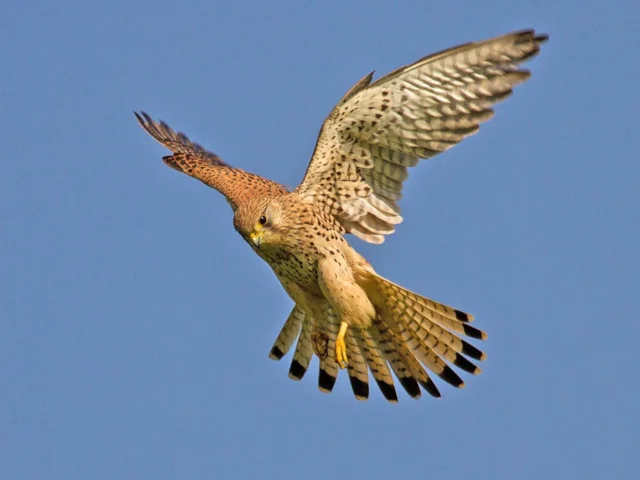Scotland’s Kestrels in severe decline
07cdca9a-42ef-4333-952d-bda36b3f90dc

As Scotland's Kestrel population plummets, RSPB conservationists have suggested that intensive farming is the cause.
Between 1995 and 2012, Kestrel numbers decreased by 65 per cent in Scotland, the biggest decline of any monitored bird species in the country, figures from the latest Breeding Bird Survey (BBS) have shown. The BBS is carried out each year by over 2,800 volunteers across the UK. In Scotland, 471 sites were monitored in 2013, but Kestrels were only observed in around 35 of them.
As a result, RSPB conservationists are carrying out urgent research to help understand why numbers of this iconic species are diminishing so rapidly. Early studies conducted by the RSPB Centre for Conservation Science suggest that intensification of agriculture could be the main reason for the significant drop in numbers. Specifically, preliminary results suggest that Kestrel numbers have fallen at times when there has been a change from spring-sown barley to autumn-sown wheat and oil seed rape.
These changes in agricultural practice means there is less food available in the winter for the rodents the falcon depends upon. Other factors which are being investigated as possible factors in the decline include: climate change, increased competition for nest sites, a rise in the use of second generation rat poisons and intra-guild predation (that is, the negative effects on Kestrels from larger predators such as Goshawks and Peregrine Falcons).
Staffan Roos, Senior Conservation Scientist at RSPB Scotland, said: “Research into what is causing the decline is vital because we can offer advice on how to increase the populations of this charismatic bird of prey. For example, we can speak with farmers about increasing field margins to boost vole numbers, which would give Kestrels a more abundant food source.
“We are already supporting practical steps which we believe will help us understand the decline better. We support the Scottish Raptor Monitoring Scheme, which recently has increased the monitoring of Kestrels and the ringing of chicks throughout Scotland. This will provide useful information on the survival and movements of [the species]. We also provide nest boxes to reduce the risk of competition for suitable nest sites.”
Brookfield Drinks, the owners of the Kestrel lager beer brand, supports the RSPB in its efforts to identify the causes of the Kestrel population decline. The money they provide is used to fund the research programme set up to help save the species, increased monitoring of it in Scotland through the Scottish Raptor Monitoring Scheme, and to advise landowners, land managers, crofters and farmers on wildlife friendly practices that will benefit the birds.
Between 1995 and 2012, Kestrel numbers decreased by 65 per cent in Scotland, the biggest decline of any monitored bird species in the country, figures from the latest Breeding Bird Survey (BBS) have shown. The BBS is carried out each year by over 2,800 volunteers across the UK. In Scotland, 471 sites were monitored in 2013, but Kestrels were only observed in around 35 of them.
As a result, RSPB conservationists are carrying out urgent research to help understand why numbers of this iconic species are diminishing so rapidly. Early studies conducted by the RSPB Centre for Conservation Science suggest that intensification of agriculture could be the main reason for the significant drop in numbers. Specifically, preliminary results suggest that Kestrel numbers have fallen at times when there has been a change from spring-sown barley to autumn-sown wheat and oil seed rape.
These changes in agricultural practice means there is less food available in the winter for the rodents the falcon depends upon. Other factors which are being investigated as possible factors in the decline include: climate change, increased competition for nest sites, a rise in the use of second generation rat poisons and intra-guild predation (that is, the negative effects on Kestrels from larger predators such as Goshawks and Peregrine Falcons).
Staffan Roos, Senior Conservation Scientist at RSPB Scotland, said: “Research into what is causing the decline is vital because we can offer advice on how to increase the populations of this charismatic bird of prey. For example, we can speak with farmers about increasing field margins to boost vole numbers, which would give Kestrels a more abundant food source.
“We are already supporting practical steps which we believe will help us understand the decline better. We support the Scottish Raptor Monitoring Scheme, which recently has increased the monitoring of Kestrels and the ringing of chicks throughout Scotland. This will provide useful information on the survival and movements of [the species]. We also provide nest boxes to reduce the risk of competition for suitable nest sites.”
Brookfield Drinks, the owners of the Kestrel lager beer brand, supports the RSPB in its efforts to identify the causes of the Kestrel population decline. The money they provide is used to fund the research programme set up to help save the species, increased monitoring of it in Scotland through the Scottish Raptor Monitoring Scheme, and to advise landowners, land managers, crofters and farmers on wildlife friendly practices that will benefit the birds.

